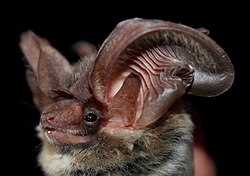Description
Idionycteris phyllotis is a bat with large ears, weighing 8 to 16 grams. On the dorsal side they possess long and soft pelage, [3] (fur). Their fur is basally blackish in color with tips that are a yellow-gray color. They have a black patch on each shoulder, a tuft of white hair on the backside of the ears, as well as ventral hairs that are black with pale tips. [3] The calcar possesses a low keel. The uropatagium has 12 to 13 transverse ribs. The rostrum is flattened and broad. [3] They have distinctive lappets (disc-shaped protrusions), which project from the base of the ears onto the brow of the bat. [4]
I. phyllotis has an external morphology common to that of gleaning bats, and are thus well adapted for plucking stationary insects from surfaces. [3] To do this they have long tragi and ears, wings adapted for maneuverability and hovering flight, and a gracile jaw. [3] I. phyllotis) is the only species in North America known to emit long, constant frequency-frequency modulated echolocation calls. [2]
This page is based on this
Wikipedia article Text is available under the
CC BY-SA 4.0 license; additional terms may apply.
Images, videos and audio are available under their respective licenses.


